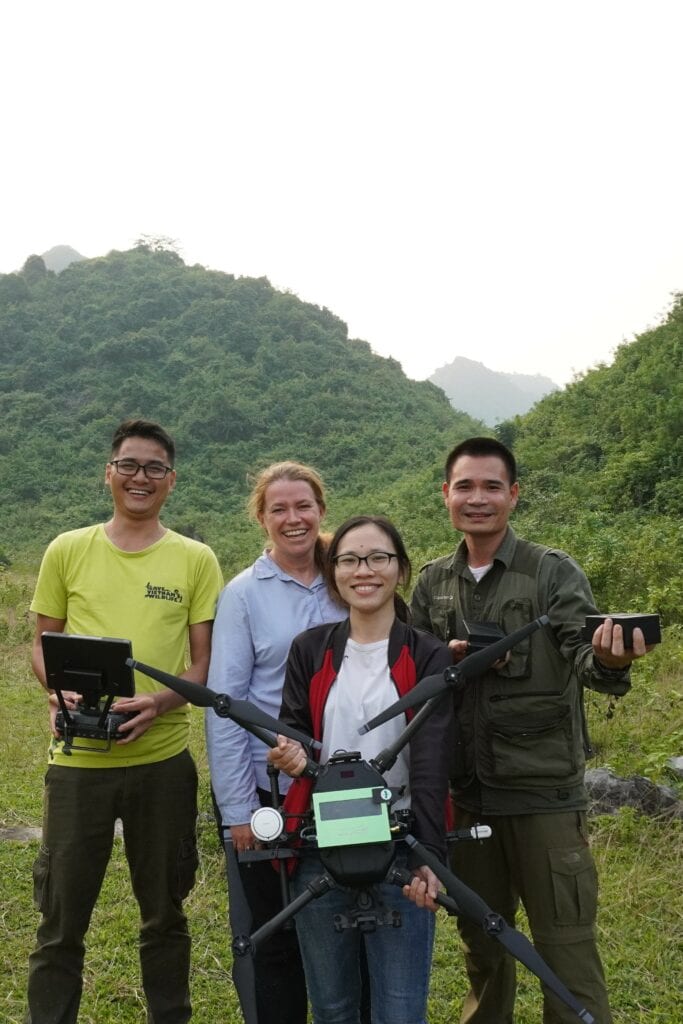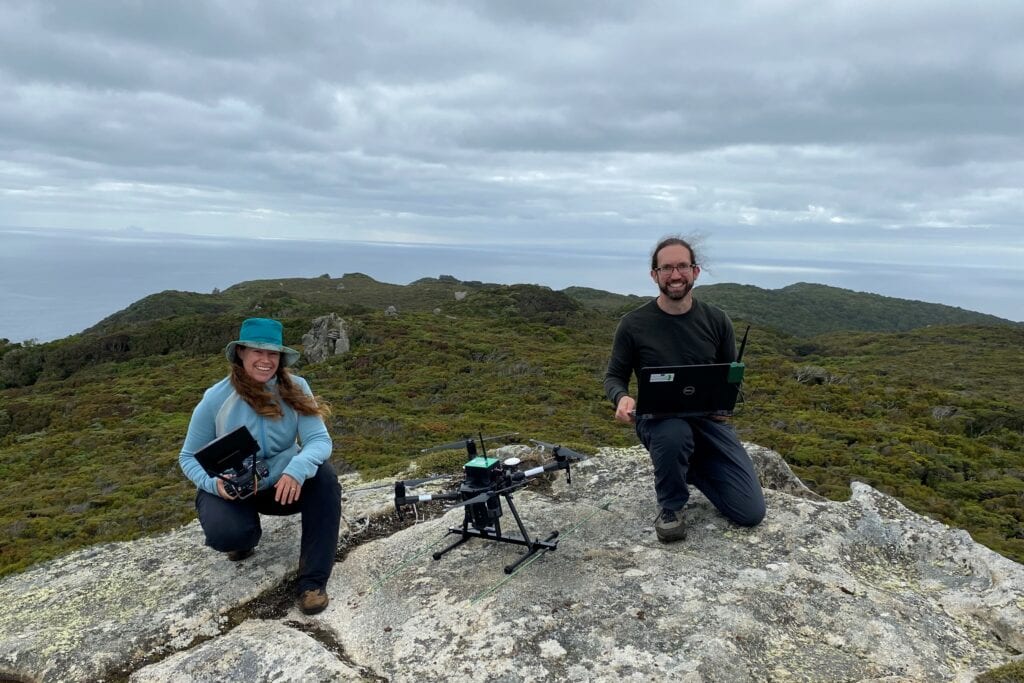Insights
Drone Pilot Stories with Dr Debbie Debbie Saunders
Part 2
In the second part of our interview with Dr Debbie Saunders, CEO, founder, and Chief Remote Pilot at Wildlife Drones, we delve deeper into her journey as a drone pilot and the remarkable impact her work has had on wildlife tracking and conservation. Join us as we explore Dr Saunders’ experiences, insights, and the incredible stories behind her innovative approach to utilising drone technology in the field of ecology.
What kind of projects do you work on?
I usually work on client projects where clients are not in a position to learn how to fly a drone but require assistance in finding their tagged animals. This often involves helping clients who have lost track of their animals during tracking projects. It’s highly rewarding when we are able to locate the animals with our drone-based telemetry system after their unsuccessful efforts.
These projects have allowed me to travel around the world, supporting wildlife professionals that are engaged in conservation initiatives. It has been an incredible experience to meet our dedicated clients and witness their impactful work firsthand, let alone have the privilege of contributing to their achievements. There is a diverse range of projects that encompass various objectives, such as reintroduction initiatives for native species, monitoring the survival of released animals (including captive-bred and rescued individuals), and studying the movements of wild animals. These projects aim to enhance our understanding of the movements of wildlife and contribute to their conservation efforts. The range of projects is diverse, not limited to threatened or endangered species, but also includes invasive species. Telemetry trackers are utilised to monitor and manage their populations, reducing their impact on the environment.

Can you walk me through your pre-flight preparation process?
When it comes to preflight preparations, the first step is to check the airspace and ensure it’s suitable for drone operations. This includes making any necessary applications or contacts, especially when flying near airports. Step two involves checking the weather conditions, paying attention to rain, wind, and visibility. Maintaining a clear line of sight with the drone is crucial, so ensuring that the fog has lifted is also important. Additionally, conducting a job safety analysis is essential. This involves completing a specific form, performing cross-checks, reviewing relevant information and notifications, and defining the safe operating area. Cross-checking field equipment and ensuring all batteries are charged is another critical task. Testing everything beforehand and having an ample supply of batteries allows for continuous flying throughout the day without needing to recharge on-site.
What safety measures do you follow while flying a drone? How do you navigate the airspace and avoid obstacles while flying?
When it comes to ensuring safe operations, one of my practices is to observe the surrounding landscape for wildlife before flying. This includes being attentive to reptiles, birds of prey, or any other animals that may interact with or get startled by the drone. By minimising any impact on these animals, the risk of animal strikes is greatly reduced.
In case a situation changes, like an eagle approaching the drone out of curiosity or other reasons, I have the ability to maneuver the drone to maintain a safe distance at all times. We strictly adhere to standard operating conditions, maintaining a distance of at least 30 meters from people and infrastructure, avoiding flying over crowds, and minimizing our impact on the environment. In areas near airports, we maintain airband radio communications to ensure the safety of piloted aircraft. If a piloted aircraft enters our operating space, we land the drone promptly and wait for a safe opportunity to relaunch. Additionally, we always conduct operations within a visual line of sight, as this allows us to proactively respond to any hazards and ensure a safer flight. Unless specific procedures are in place, such as extended visual line of sight or beyond-the-line-of-sight operations, we prioritize maintaining visual contact with the drone. Most of our operations do not require these advanced certifications.
What is the most challenging aspect of being a drone pilot?
One of the most challenging aspects of being a drone pilot is the unpredictable nature of weather conditions. The ever-changing weather can pose significant challenges, especially when projects require immediate implementation. It can be frustrating when bad weather hinders projects and forces us to wait for better conditions. It also means that we appreciate the opportunity to seize clear, calm days and make the most of them. On beautiful sunny days, with crisp conditions and not much wind, it really is a joy to be out flying the drones.
Can you describe a particularly memorable flight experience?
One of the most unforgettable flight experiences I’ve had took place on Whenua Hou Island, located off the South coast of New Zealand, where we were tracking Kākāpō. It was an extraordinary adventure, standing at the top of the island, launching our drone from a rock, and flying over vast areas covered in dense vegetation that would have been really challenging to track on foot. The region is renowned for its often unfavourable weather conditions, but during our brief stay, we were fortunate to enjoy magnificent weather. While the wind did pick up, it remained well within the drone’s capabilities. Tracking such a rare species and assisting in their conservation efforts was fantastic. The freedom to fly unhindered, above the canopy within the bounds of maintaining line-of-sight, and without any obstructions was a remarkable experience. Moreover, being surrounded by the breathtaking landscape added to the privilege, and sharing this adventure with indigenous representatives who provided valuable insights and shared their stories made the experience even more meaningful and memorable.

How do you stay up-to-date on the latest drone technology and regulations?
I am a member of two prominent drone associations: the Australian National Drone Pilots Association (ANDPA) and the Australia Association Uncrewed Systems (AAUS). These associations play a vital role in keeping members informed about the latest regulations and also provide opportunities for industry input. Additionally, I subscribe to various blog posts and follow tech companies that consistently share valuable information about the latest advancements in drone technology. It’s crucial to stay connected with drone manufacturers who are constantly pushing the boundaries of what is achievable in terms of drone flight.
What advice would you give to someone who is interested in becoming a drone pilot?
If you’re really interested in becoming a drone pilot, you should take the leap. It opens up a whole new world of different perspectives, and the possibilities are almost limitless, limited only by your imagination. Drones serve as a flexible platform and a powerful tool that can greatly enhance data collection efforts while providing fantastic imagery. While it may appear complex or challenging at first, it’s not as difficult as it may seem. However, it’s essential to exercise caution, be well-organised, and prioritise safety when operating drone equipment. By managing risks effectively, you can minimise potential issues and enjoy a smooth experience. There’s no reason not to give it a try and explore the incredible opportunities that await.
Want to learn more about becoming a Drone Pilot in Australia?
The training program we provide covers various aspects of drone flying, from the basics to the advanced deployment of our technology. Partnering with Aviassist, an award-winning drone company, we ensure that participants receive high-quality instruction and gain the necessary skills to become qualified pilots. The training courses not only focus on flying techniques but also highlight the benefits of Wildlife Drones’ innovative technology, giving pilots a competitive edge in the industry.
Follow this link.

